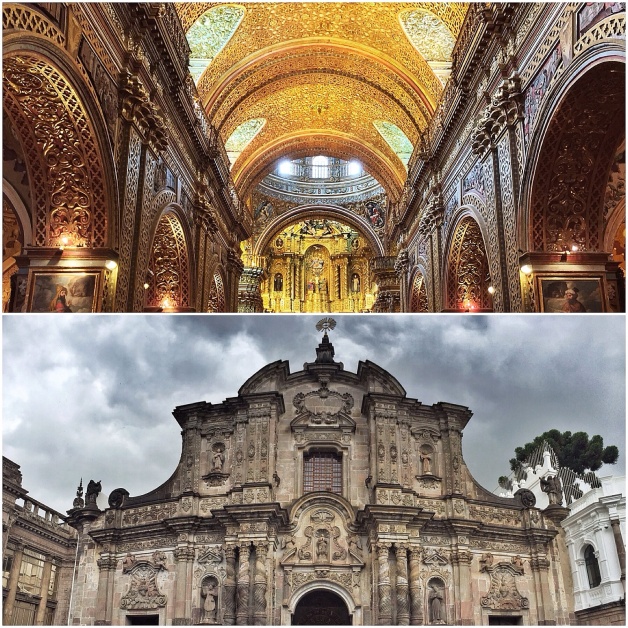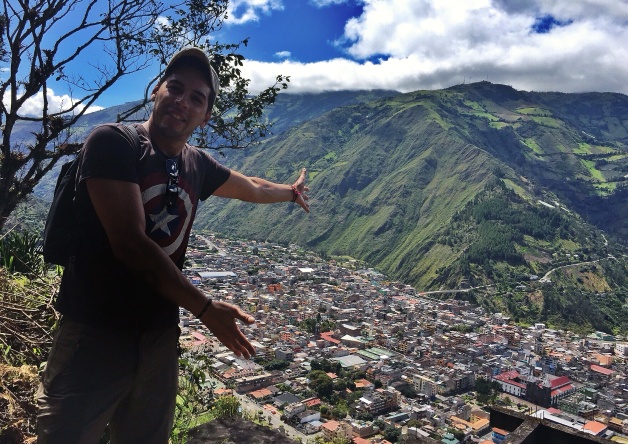Round the World trip
November 2014 – May 2015
week 17 and 18 of 24
ECUADOR
Quito and the Andes.
by Xavier
“You see, the first thing we love is a scene. For love at first sight requires the very sign of its suddenness; and of all things, it is the scene which seems to be seen best for the first time: a curtain parts and what had not yet ever been seen is devoured by the eyes…”
— Roland Barthes, A Lover’s Discourse: Fragments.
OK there were some bits of Colombia that I liked a lot: the nights out in Bogotá, the hotel pool in Santa Marta, the friends we made in San Agustín… but I wasn’t bowled over by Colombia, or really got as much from it as Simon did – he loved it. So I worried that South America was not quite going to do it for me this time, and we still had over two months to go. All of this was weighting on my mind as we were making our way into Quito from the border. Another road, another stuffy old bus. Then I looked out of the window and my jaw dropped. We were approaching the town of Ibarra, half way between the border and our destination. I could see it in the distance, small and flat, and framed by an immense volcano shrouded in thick white clouds. It was an incredible scene, and I was mesmerised. It got dark by the time we reached the outskirts of Quito, higher than the sprawling city itself. The view of the city lights from the road was like the view from a plane, which I always find very exciting. At the bus station we said goodbye to our Dutch friends and found a taxi. As we chatted to the driver and took in the views I thought to myself I was going to like this place.
I loved Quito. A lot. We stayed in a great hostel in La Floresta which had amazing views (when the fog permitted; there seems to be a lot of fog in Ecuador), and spent a few days exploring the city, though the weather turned cold and wet (and foggy) so not as much exploring as we would have liked. The old town is a legacy of Quito’s wealthy and deeply religious colonial past. We visited some beautiful churches, like the Iglesia de San Agustín, the Cathedral, and one of Quito’s highlights: the Iglesia de la Compañía de Jesús, a (mainly) baroque extravaganza built by the Jesuits between 1605 and 1765, and decorated with – we were told – about seven tons of gold leaf, which says a lot about the priorities of the Church. There were some museums too. Casa del Alabado is a restored late 1600’s Spanish house that hosts an excellent collection of pre-Columbian art, with some items on display dating from about 4,000 B.C. It was well worth the visit. We also tried some typical food, like fanesca, a hearty soup traditionally eaten during Easter. We hung out in Plaza Foch a few times, did a bit of shopping (I found a small shop in the old town where a group of young designers sell some cool stuff), and wined and dined at a couple of hip restaurants near our hostel.
One of the things we wanted to do while in Ecuador was to go to Galápagos Islands. After Easter Island, Galápagos was the main highlight of our penciled itinerary. It was in Quito where we finally decided not to go. Our travel budget is already on the overstretched side, particularly after the time we spent in the South Pacific. Oh well, next time. On the up side, we now had some extra time in our hands, so decided to extend our stay in Quito for two more days before heading south. The rain and the cold spoiled these days a bit but we managed to enjoy ourselves, and I really hope to come back to this wonderful city at some point.
From Quito we travelled south to Baños de Agua Santa (or just Baños), a small town reminiscing of Vang Vieng in both setting and main activities. The weather was fortunately a lot better than in Quito, which was just as well, because there is nothing to do in Baños other than outdoorsy stuff – well, while Baños is fairly dead midweek, thousands of people descended on it for the weekend, and the centre of town turns into a massive Latin party on Saturday nights, as we found out. Baños offers a wide range of outdoor activities: hiking, paragliding, white water rafting, canyoning, zip lining, mountain biking, swinging off bridges, etc, etc. We chickened out of the most thrill seeking ones (for me a thrill is to sit in the lower rows at the IMAX) but managed to cycle to the Pailón del Diablo (the Devil’s Cauldron), a spectacular waterfall about 20 kilometres from Baños, and a couple of strenuous hikes through the farming land just outside the town – the first hike we did totally disproved the theory of infinite universes where everything is possible because there is just no way there exists a universe where I could have climbed that hill without stopping every couple of meters to catch my breath; the second hike ended up on an unwitting game of Mud Or Shit, with an ever increasing amount of both. Great views though. Simon even tried the thermal pools that give the place its name, but they were apparently crowded and not terribly clean, so he wasn’t very impressed. Our hostel was fairly out of town, good for the views and very tranquil, but a bit of a pain for getting to and from town, which we ended up doing more than anticipated, not least on account of hanging out in the evenings with some of the guys we met in San Agustín, who are travelling a similar route to us and happened to be in Baños over the same few days, which was great fun.
And from Baños we made our way to Cuenca, Ecuador’s most important colonial city after Quito, mainly to break the long journey towards the border with Peru. We only stayed a couple of nights, at a very quiet B&B just outside the old town. Cuenca was very pleasant. Simon, as usual, found an excellent restaurant on the first night, then we spent the next day seeing the sites along Mariscal Sucre and Calle Larga, two of the main streets. We saw some works by Ecuadorian artists at the Museo de Arte Contemporaneo, and walked the long way to the Museo del Banco Central, touted as Cuenca’s most important museum and so on, but actually very odd. The only thing of some interest that we found was its permanent ethnological exhibition, about the different indigenous Andean peoples of Ecuador, especially the section dedicated to the Shuar culture and its custom of shrinking human heads – tzantzas – and yes, there are a few on display. With not much else to do, we spent the rest of the time in cafés, and looking for a place where to fix my wristwatch, which turns out was never water proof after all.
After Cuenca, the plan was to head straight for the border. I liked the idea of stopping by the sea first, as we’ll just have one more chance on this trip when we get to Peru, so at my insistence Simon agreed to make a detour from our planned route and hit the coast north-west of Guayaquil – adding eventually about 15 hours of bus journeys, so I hope it’s worth it.
We are now in Montañita, a very popular and, er, lively beach town, where we have to wear a wristband with the details of the hostel, and the ratio of people to dodgy cocktail bars seems to be one to one, as if we have materialised in an episode of Sun, sex, and suspicious parents. Definitely watch this space.
previous | next about this blog
_________________________________________________________

















Pingback: Telling the tale. | we are out of the office
Pingback: Shake, shake, shake, Señora. | we are out of the office
Pingback: El cóndor pasa. | we are out of the office